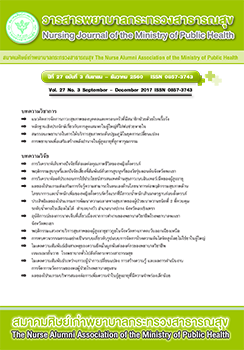Smoking Behavior and Risk Factors Associated with Smoking of Early Adolescents in Phayao Province, Thailand
Main Article Content
Abstract
This cross-sectional survey study was conducted to investigate prevalence of smoking in adolescents, the relationship between personality factors and perceived environment and socialization, and factors predicting smoking behavior of early adolescents. The sample consisted of 392 Thai students studying in two secondary schools and two vocational education colleges located in Phayao province, Thailand. Data were collected using self-administered questionnaires. Descriptive statistics and Chi-square tests were used to analyze relationships between variables. Logistic regression was used to calculate odds ratios. The result found that the prevalence of smoking was 31.1%. The minimum age of early smoking initiation was 13 years. The smoking rates of male and female adolescents were 54.4 % and 13.2 %, respectively. The reasons for being a smoker were curiosity (43.4%), stress reduction (32.8%) and persuasion of friends (22.1%). The predicting factors for smoking behavior was sex. Male adolescents had a 3.78 times greater chance of smoking than females (OR= 3.78). The second most important factor was having parents or friends who smoked. They were 3.55 times more likely to be smokers, as compared to those having non-smoking parents nor friends. Moreover, having a positive attitude towards smoking and academic achievement were the other significant factors related to smoking behavior in adolescents.
The findings suggest that family and educational institutions play an important role to enhance positive attitudes among early adolescents and to become non-smoking role models for them. The educational institutes should have restricted policies and rules to prevent the students from smoking.
Article Details
บทความและรายงานวิจัยในวารสารพยาบาลกระทรวงสาธารณสุข เป็นความคิดเห็นของ ผู้เขียน มิใช่ของคณะผู้จัดทำ และมิใช่ความรับผิดชอบของสมาคมศิษย์เก่าพยาบาลกระทรวงสาธารณสุข ซึ่งสามารถนำไปอ้างอิงได้
References
2. Pitayarangsarit S, IamananP, Punkrajang P, Sommit K. Tobacco consumption control situation in Thailand 2012. 3rd ed. Bangkok:Charoendee Munkong Printing; 2012. (in Thai).
3. Pitayarangsarit S, Sommit K, Iamanan P. Tobacco consumption control situation in Thailand by provinces 2011. Bangkok:Charoendee Munkong Printing; 2012. (in Thai).
4. Thai Health Promotion Foundation. Tobacco as adrug [internet]. 2013 [cited 2013 May 2].Available fromhttp://www.thaihealth.or.th/Content/6834
5. Thanomat K, Sunsern R. Factors related to early smoking stage among male students at lower secondary school under the jurisdiction of The Trat Education Service Area Office. Journal of Nursing and Education 2011; 4(3):38-47.(in Thai).
6. Sakornpanich C. Factors associated with non-smoking high school male students intention to smoke. J PrapokklaoHospClin Med Educat Center 2011; 28(1):44-52. (in Thai).
7. Frances MC, Richard J, Mark ST. (2007). College student involvement in cigarette smoking: The role of psychosocial and behavioral protection and risk. Nicotine & Tobacco Research 2007; 9(2):213–24.
8. Meethong N. Causal factors related to smoking behavior among female students of vocational education colleges in Bangkok Metropolis [Master Thesis]. Bangkok: Srinakharinwirot University. 2008. (in Thai).
9. Donovan EJ. Problem Behavior Theory. In Fisher CB, Lerner RM, editors. Encyclopedia of Applied Developmental Science (Vol.2). Thousand Oaks, CA: Sage, 2005. p. 872-77
10. Rew L. Adolescent health: a multidisciplinary approach to theory,research and Intervention. California: Sage Publications; 2005.
11. Kengganpanich T, KengganpanichM, Termsirikulchai L. Factors influencing on young women smoking in Thailand. Journal of Health Education 2008; 31(108):26-40. (in Thai).
12. Tobacco Control Research and Knowledge Management Center. Global Youth Tobacco Survey [internet]. 2011 [cited 2013 May 2]. Available from http://www.trc.or.th/th/index. php?option=com_content&view=article&id=93&Itemid=930
13. Chaikoolvatana C, Powwattana A, Lagampan S, Jirapongsuwan A, Bennet T. Development of a school-based pregnancy prevention model for early adolescent female Thais. Pracific Rim Int J Nurs Res 2013; 17(2): 131-47.
14. Jankaewe J, Homsin P, Srisuriyawet R. Factors Related to Smoking Initiation among Male Students in Lower Secondary Schools, PathumTani. Journal of Nursing Science Chulalongkorn University 2015; 27(2): 99-109.
15. Chaikoolvatana A, Manwong M, Chaikoolvatana C, Saisingh N, Wongthanu S, Kwangtong M.Prevalence and factors influencing smoking behaviors among vocational and technical students in a North-Eastern Province of Thailand. Chula Med J 2016; 60(2): 1-17.
16. Boonserm C, Suthitiwanich P, Worrasa R.Smoking behaviors among youth in Chaiyaphum Province. Journal of Health Science 2009; 3(2):6-14 (in Thai).
17. Eun SS, Ji YY. Factors Associated with Early Smoking Imitation among Korean Adolescent. Asian Nursing Research 2015;9:115-19.
18. KoonkumA. Factors relating to smoking prevention behavior of male students in the upper secondary schools under the jurisdiction of the officeof UbonRatchathani Educational Service Area 2 [Master Thesis]. UbonRatchathani:UbonRatchatani Rajabhat University. 2010. (in Thai).
19. Ungchatoen R, Seeherunwong A, Kongsakon R, Sujirarat D. Beliefs and Attitudes toward smoking cessation among vocational students with nicotine addiction and non-addiction. Journal of Nursing science 2014; 32(4):52-62. (in Thai).

